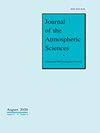仔细观察不同环境条件下过冷云滴温度和寿命的演变,对云蒸发区的冰核产生影响
IF 2.8
3区 地球科学
Q2 METEOROLOGY & ATMOSPHERIC SCIENCES
引用次数: 0
摘要
本研究研究了考虑初始液滴半径(r0)和温度(Tr0)以及环境相对湿度(RH)、温度(T∞)和压力(P)的蒸发过冷云滴的温度和寿命的演变。计算了液滴在突然引入新的亚饱和环境后达到较低稳态温度(tss)所需的时间(tss)、ΔT=T∞−tss的大小以及tss时的液滴存活时间(tst)。ΔT随着T∞的增加而增加,随着RH和P的增加而减少。ΔT通常比T∞低1-5K,在非常低的RH、低的P和接近0°C的T∞下具有最高值(~10.3K)。结果表明,在考虑初始液滴和环境条件的范围内,tss<0.5s。较大的液滴(r0=30至50μm)可以在Tss下存活约15s至3分钟以上,这取决于环境的亚饱和度。对于较高的RH和较大的液滴,与忽略液滴冷却的液滴相比,液滴寿命可以增加100秒以上。蒸发液滴的Tss可以通过环境热力学湿球温度来近似。辐射对液滴温度的影响很小,但在接近饱和的环境中较大的液滴除外。讨论了在云顶生成细胞和云边缘附近形成冰核的意义。在广泛使用的参数化方案中使用Tss而不是T∞可以导致活性冰成核颗粒(INPs)的数量浓度增加2-30的典型因子,最大的增加(≥100)与低RH、低P一致,T∞接近0°C。本文章由计算机程序翻译,如有差异,请以英文原文为准。
A closer look at the evolution of supercooled cloud droplet temperature and lifetime in different environmental conditions with implications for ice nucleation in the evaporating regions of clouds
This study investigates the evolution of temperature and lifetime of evaporating, supercooled cloud droplets considering initial droplet radius (r0) and temperature (Tr0), and environmental relative humidity (RH), temperature (T∞) and pressure (P). The time (tss) required by droplets to reach a lower steady-state temperature (Tss) after sudden introduction into a new subsaturated environment, the magnitude of ΔT = T∞ − Tss, and droplet survival time (tst) at Tss are calculated. ΔT is found to increase with T∞, and decrease with RH and P. ΔT was typically 1-5K lower than T∞, with highest values (~10.3K) for very low RH, low P, and T∞ closer to 0°C. Results show that tss is < 0.5s over the range of initial droplet and environmental conditions considered. Larger droplets (r0 = 30 to 50 μm) can survive at Tss for about 15s to over 3 minutes, depending on the subsaturation of the environment. For higher RH and larger droplets, droplet lifetimes can increase by more than 100s compared to those with droplet cooling ignored. Tss of the evaporating droplets can be approximated by the environmental thermodynamic wet-bulb temperature. Radiation was found to play a minor role in influencing droplet temperatures, except for larger droplets in environments close to saturation. The implications for ice nucleation in cloud-top generating cells and near cloud edges are discussed. Using Tss instead of T∞ in widely-used parameterization schemes could lead to enhanced number concentrations of activated ice-nucleating particles (INPs), by a typical factor of 2-30, with the greatest increases (≥100) coincident with low RH, low P, and T∞ closer to 0°C.
求助全文
通过发布文献求助,成功后即可免费获取论文全文。
去求助
来源期刊

Journal of the Atmospheric Sciences
地学-气象与大气科学
CiteScore
0.20
自引率
22.60%
发文量
196
审稿时长
3-6 weeks
期刊介绍:
The Journal of the Atmospheric Sciences (JAS) publishes basic research related to the physics, dynamics, and chemistry of the atmosphere of Earth and other planets, with emphasis on the quantitative and deductive aspects of the subject.
The links provide detailed information for readers, authors, reviewers, and those who wish to submit a manuscript for consideration.
 求助内容:
求助内容: 应助结果提醒方式:
应助结果提醒方式:


